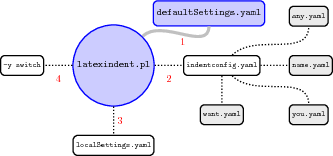4. indentconfig.yaml, local settings and the -y switch¶
The behaviour of latexindent.pl is controlled from the settings
specified in any of the YAML files that you tell it to load. By default,
latexindent.pl will only load defaultSettings.yaml, but there
are a few ways that you can tell it to load your own settings files.
4.1. indentconfig.yaml and .indentconfig.yaml¶
latexindent.pl will always check your home directory for
indentconfig.yaml and .indentconfig.yaml (unless it is called
with the -d switch), which is a plain text file you can create that
contains the absolute paths for any settings files that you wish
latexindent.pl to load. There is no difference between
indentconfig.yaml and .indentconfig.yaml, other than the fact
that .indentconfig.yaml is a ‘hidden’ file; thank you to Diaz (2014)
for providing this feature. In what follows, we will use
indentconfig.yaml, but it is understood that this could equally
represent .indentconfig.yaml. If you have both files in existence
then indentconfig.yaml takes priority.
For Mac and Linux users, their home directory is /username while
Windows (Vista onwards) is C:\Users\username [1]
Listing 12 shows a sample indentconfig.yaml file.
# Paths to user settings for latexindent.pl
#
# Note that the settings will be read in the order you
# specify here- each successive settings file will overwrite
# the variables that you specify
paths:
- /home/cmhughes/Documents/yamlfiles/mysettings.yaml
- /home/cmhughes/folder/othersettings.yaml
- /some/other/folder/anynameyouwant.yaml
- C:\Users\chughes\Documents\mysettings.yaml
- C:\Users\chughes\Desktop\test spaces\more spaces.yaml
Note that the .yaml files you specify in indentconfig.yaml will
be loaded in the order in which you write them. Each file doesn’t have
to have every switch from defaultSettings.yaml; in fact, I recommend
that you only keep the switches that you want to change in these
settings files.
To get started with your own settings file, you might like to save a
copy of defaultSettings.yaml in another directory and call it, for
example, mysettings.yaml. Once you have added the path to
indentconfig.yaml you can change the switches and add more
code-block names to it as you see fit – have a look at
Listing 13 for an example that uses four tabs for the
default indent, adds the tabbing environment/command to the list of
environments that contains alignment delimiters; you might also like to
refer to the many YAML files detailed throughout the rest of this
documentation.
# Default value of indentation
defaultIndent: "\t\t\t\t"
# environments that have tab delimiters, add more
# as needed
lookForAlignDelims:
tabbing: 1
You can make sure that your settings are loaded by checking
indent.log for details – if you have specified a path that
latexindent.pl doesn’t recognize then you’ll get a warning,
otherwise you’ll get confirmation that latexindent.pl has read your
settings file. [2]
When editing .yaml files it is extremely important to remember how
sensitive they are to spaces. I highly recommend copying and pasting
from defaultSettings.yaml when you create your first
whatevernameyoulike.yaml file.
If latexindent.pl can not read your .yaml file it will tell you
so in indent.log.
4.2. localSettings.yaml¶
The -l switch tells latexindent.pl to look for
localSettings.yaml in the same directory as myfile.tex. For
example, if you use the following command
latexindent.pl -l myfile.tex
then latexindent.pl will (assuming it exists) load
localSettings.yaml from the same directory as myfile.tex.
If you’d prefer to name your localSettings.yaml file something
different, (say, mysettings.yaml as in Listing 13)
then you can call latexindent.pl using, for example,
latexindent.pl -l=mysettings.yaml myfile.tex
Any settings file(s) specified using the -l switch will be read
after defaultSettings.yaml and, assuming they exist, any user
setting files specified in indentconfig.yaml.
Your settings file can contain any switches that you’d like to change; a sample is shown in Listing 14, and you’ll find plenty of further examples throughout this manual.
# verbatim environments - environments specified
# here will not be changed at all!
verbatimEnvironments:
cmhenvironment: 0
myenv: 1
You can make sure that your settings file has been loaded by checking
indent.log for details; if it can not be read then you receive a
warning, otherwise you’ll get confirmation that latexindent.pl has
read your settings file.
4.3. The -y|yaml switch¶
You may use the -y switch to load your settings; for example, if you
wished to specify the settings from Listing 14 using
the -y switch, then you could use the following command:
latexindent.pl -y="verbatimEnvironments:cmhenvironment:0;myenv:1" myfile.tex
Note the use of ; to specify another field within
verbatimEnvironments. This is shorthand, and equivalent, to using
the following command:
latexindent.pl -y="verbatimEnvironments:cmhenvironment:0,verbatimEnvironments:myenv:1" myfile.tex
You may, of course, specify settings using the -y switch as well as,
for example, settings loaded using the -l switch; for example,
latexindent.pl -l=mysettings.yaml -y="verbatimEnvironments:cmhenvironment:0;myenv:1" myfile.tex
Any settings specified using the -y switch will be loaded after
any specified using indentconfig.yaml and the -l switch.
4.4. Settings load order¶
latexindent.pl loads the settings files in the following order:
defaultSettings.yamlis always loaded, and can not be renamed;anyUserSettings.yamland any other arbitrarily-named files specified inindentconfig.yaml;localSettings.yamlbut only if found in the same directory asmyfile.texand called with-lswitch; this file can be renamed, provided that the call tolatexindent.plis adjusted accordingly (see Section 4.2). You may specify both relative and absolute *-l absolute paths paths to other YAML files using the-lswitch, separating multiple files using commas;- any settings specified in the
-yswitch.
A visual representation of this is given in Fig. 1.

Fig. 1 Schematic of the load order described in Section 4.4;
solid lines represent mandatory files, dotted lines represent
optional files. indentconfig.yaml can contain as many files as
you like. The files will be loaded in order; if you specify settings
for the same field in more than one file, the most recent takes
priority.
| [1] | If you’re not sure where to put indentconfig.yaml, don’t worry
latexindent.pl will tell you in the log file exactly where to put
it assuming it doesn’t exist already. |
| [2] | Windows users may find that they have to end .yaml files with a
blank line |